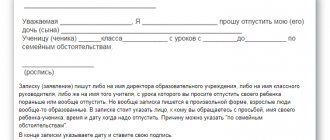Why do they write an explanatory note?
A person has to write an explanatory note not because the addressee is actively interested in the events taking place in the author’s life. Statement of the circumstances of the incident from the point of view of its participant is an opportunity to make a fair decision. The reason for writing an explanatory note is most often negative events: being late for work, missing school, an unfulfilled assignment, etc.
In cases where the culprit faces serious punishment - for example, dismissal or disciplinary action - an explanatory note can become a reason for lifting sanctions or, on the contrary, will be a supporting document.
Sometimes explanations become an argument of the parties in court; they can protect the employee or employer from liability or become evidence.
How can an employer request an explanation for absenteeism?
Absenteeism is the absence of an employee from the workplace for more than 4 hours. It is important to distinguish this from forced absenteeism, when absence from work is due to the actions of the manager.
Before receiving an explanatory note from an employee, you should prepare an absenteeism report, which includes testimony:
- immediate superior;
- at least two witnesses confirming the failure to appear.
Internal investigations into violations of discipline of any type can be carried out no later than within a month from the date of the commission of the offense.
Where are explanatory notes written?
Explaining your own or someone else’s behavior is accepted in several areas:
At the place of work
A note is written by an employee if he violated labor discipline (was late for work, came drunk, did not submit a report on time, did not wear special clothing, etc.), caused material damage to his employer, is involved in a labor dispute, and in other similar situations. Explanatory notes for lateness and other incidents are usually submitted to the personnel department, the head of the department, or directly to the employer (if it is, say, an individual entrepreneur).
At the place of study
In this case, there may be two options. If we are talking about a school, the explanatory note is written by the parents or the student himself (depending on the age of the student). In higher and secondary educational institutions, notes are written by the student, and in some cases by his parents or legal representatives.
To a kindergarten
Explanatory notes are submitted to preschool institutions by parents, and they explain their actions (for example, the reasons for the child’s absence or late payment), and not the actions of the children.

Deadlines for writing explanatory notes
Labor legislation establishes a clear deadline for providing an explanatory note. Article 193 of the Labor Code of the Russian Federation obliges the employer not to impose a disciplinary sanction within two working days after the request for an explanation from the employee. If the employee does not write a note within these two days, the period is considered expired.
The administration of these organizations decides at what time to provide explanatory notes at the place of study, kindergarten and other institutions, and the period must be reasonable.
The procedure for bringing to “disciplinary liability”, established by law
In order to identify the perpetrators and determine the degree of their guilt, the manager must:
• appoint a commission to conduct an internal investigation;
• notify the employee of the need to provide explanations;
• comply with the deadlines for providing explanations;
• adhere to the deadlines for bringing to justice;
• get acquainted with the results of the official proceedings and make a decision regarding the persons subject to liability;
• familiarize the perpetrators with the “order to bring to justice.”
If in your situation the administration neglected and/or you do not agree with the penalty imposed on you, when reading the order, write about your disagreement directly on the form itself.
Legal meaning of explanatory notes
Such notes have significant legal significance, especially when it comes to labor relations. According to the Labor Code of the Russian Federation, employee explanations are a mandatory part of the procedure for bringing to disciplinary liability. Until the explanatory note is received (if the deadline for its provision specified in the previous chapter has not expired), no measures can be taken against the employee.
It is not only the fact of providing an explanation that is important, but also its content. Based on the note, the employer can either apply the maximum possible penalty or cancel the employee’s punishment completely. In other words, if you were late for work or did not complete any assignment for a good reason, then an explanatory note can save you from punishment from the employer.
At the same time, writing an explanatory note is not mandatory for the employee; he can refuse to do so without any legal consequences (except that the employer will make a decision based either only on his own assessment of the situation, or on the assessment of witnesses and other participants in the event ).
Refusal to provide written explanations
The individual providing the work requests an explanation from the employee in order to explain certain actions and behaviors. The employee has the right to refuse to write this document, but this fact will not work in his favor.
By refusing to write a document, the employee is at greater risk of receiving the following penalties:
- Notes,
- reprimand,
- Penalties,
- Layoffs,
- Other types of punishments that are appropriate in the opinion of the employer.
By competently writing a note and clearly explaining all the facts, the employee significantly increases his chances of mitigating his guilt or being completely acquitted in the eyes of the employer.
Method of writing an explanatory note
Legislation and everyday customs provide for two ways of writing explanatory notes:
- Writing by hand is the preferred method because it allows identification of the author and also makes it possible to avoid forgery. But even if the note is not written by the author himself, it must contain his own signature.
- Writing on a computer is more often used in organizations where a clear form of such documents has been established. Whatever the text, the signature must be handwritten.
How exactly to write an explanatory note is the personal choice of its author.
How to write an explanatory note
Despite the different requirements for the form and type of explanatory note in different organizations, there are also general requirements.
Addressee of the explanatory note
Depends on the size of the organization, as well as the reason for writing the note. If the enterprise or institution is small, an explanatory note is written to the manager. In organizations with a complex structure, the addressee may be the head of a department (head of a workshop, department, department, section, etc.).
If we are talking about explanatory notes at the place of study, they are usually submitted to the rector or head of the academic department, or the school director. In kindergarten - addressed to the head.
Samples of explanatory notes
Despite the fact that the text of the note can be invented from scratch, there is no point in reinventing the wheel. We offer you examples of explanatory notes that you can successfully use in your life situations.
Explanatory note at the place of work
There may be several reasons for drawing up such documents.
About failure to fulfill official duties - the watchman did not walk around the territory, as a result of which theft occurred, the accountant did not send a report, because of which the company suffered losses, etc. In this case, you need to find compelling explanations for your actions (or inaction). It is highly undesirable to blame colleagues or management for what happened; the note should explain your behavior.

Sample explanatory note for work
2 About errors in work - we mean unintentional errors in calculations, in the actions of the employee, etc. The best strategy here is to admit the mistake and promise not to do it again. An attempt to blame another person for an error is permissible only if there is documentary evidence.

Sample explanatory note for work about errors
about violations of labor discipline - absenteeism, tardiness, absence during working hours, violation of instructions and regulations, etc. Since most of these violations attract at least disciplinary action, the reason must be described very convincingly.

Sample explanatory note for work about being late for work

Sample explanatory note about absence from work
Explanatory note at the place of study
The text depends on the place where the note is submitted, and on whether the student himself explains his action or his parents do it:
1 To school - most often parents explain the reason for their son or daughter’s absence from classes. This could be illness, participation in competitions or other events, or family circumstances. If in the lower grades the class teacher most often does not require documentary evidence of explanations, then in the upper grades, if there is no certificate from a doctor, convincing arguments are required in the explanatory note to the school.

Sample explanatory note to school
2 To a university or secondary specialized educational institution - parents or the student himself explains the reason for absence from lectures, seminars or exams. Poor health or undocumented illnesses will not go away more than once.

Sample explanatory note to the university
Explanatory note in kindergarten
This is a document on the basis of which parents can, for example, return the amount paid for the child’s food on the day he missed. But valid reasons for absence are required.

Sample explanatory note to kindergarten
How to write an explanatory note correctly so as not to be punished
Legislative norms do not clearly define the form for drawing up an explanatory note. But there are certain rules regulated by document flow. If you follow them, it will not be difficult to correctly format this kind of note.
Basic requirements:
- Draw up a note by hand or printed text on an A4 sheet of paper. It is recommended to use a computer as not everyone has legible handwriting.
- Stick to the optimal volume of presentation - a few sentences will be enough, but to the point. More details will be required only in situations where the employee’s actions could cause serious harm to the health of other people (including death) or lead to the ruin of the organization. financial losses of the organization.
- Information is presented in a business style, without colloquial or emotional statements.
- The presentation of events must follow logic and chronology, without final conclusions.
Before you start writing an explanatory note, it is recommended to carefully consider its content. Naturally, deception is not welcome here, but it would be unreasonable to justify the violation with some ridiculous reason (for example, “I was late for work because I didn’t hear the alarm clock”).
A correctly drafted explanatory statement indicating specific facts and weighty arguments in favor of the guilty person can have a positive impact on the “verdict.”
Important! According to Art. 193 of the Labor Code of the Russian Federation, the employee must write an explanatory note no later than 2 days from the date of receipt of the request. The period is extended if the offender is not at work for a valid reason, which must be documented (sick leave, business trip or vacation order, etc.).
Required details
An explanatory note, like any other document, must include certain details:
- the full name of the company where the offending employee works;
- information about the person being addressed (full name, position);
- name (in our case – “Explanatory Note”);
- date, month and year of compilation and signature with transcript;
- serial number (put down in the HR department according to the entry made in the registration journal).
Important! If the offender refuses to put his explanations on paper, a corresponding act is drawn up with the signatures of two witnesses.
Text of the explanatory note
The “body” of the document or explanatory text is conventionally divided into 2 parts:
- factual, which sets out specific facts about the misconduct or violation committed (for example, “On such and such a date I did not complete the task assigned to me”);
- causal, including justification for the current situation (example - “I was not able to gain access to the necessary equipment”).
See also: How to get a job without experience. Step-by-step instructions + job search sites
Both must contain objective information and clearly stated reasons. At the end, you can express your attitude regarding this aspect - admission or non-admission of guilt. It is necessary to write an explanatory note correctly so as not to be punished as objectively as possible. Everything should be reduced to the minimum of your guilt, but still to its recognition; those who do nothing are not mistaken. And at the end, be sure to add that you will take into account the mistakes made in your work and will not make them in the future.
Dating Features
At the bottom of the note is the date it was issued, and not the day the offense was committed. It is from her that the time is counted - according to the law, a disciplinary sanction can be imposed on a guilty person only within a month after his discovery.
Procedure for writing a note
So, let's look at the standard plan for drawing up an explanatory note:
- The note header is filled in in the upper right corner of the sheet. The following information is entered into it: full name of the recipient and his position, name of the company. Just below are the initials of the compiler and what position he holds.
- On a new line in the middle, write the name of the document - “Explanatory Note”.
- On a new line, stepping back, they move on to a description of the violation committed and for what reasons it happened. You can end this part with an apology or a promise that this will not happen again.
- Below, on the left, indicate the date the document was written.
- On the contrary, but only on the right, they put their signature and decipher it next to it.
Even when preparing a paper in printed form, you must sign at the bottom by hand.

Appendixes to the explanatory note
It is advisable to attach attachments to the explanatory paper to mitigate the guilt of the offending employee. These are certificates from the hospital, various acts, articles from mass sources of information (on the topic in question), photos from the scene of the incident, etc.
FAQ
– What will happen if I refuse to write an explanatory note?
– As mentioned above, there is no liability for refusal to write an explanatory note. However, if the employee does not want to explain his actions, the employer must draw up a report on this (the same applies to the situation when the employee did not submit the note within two days). The “Act of Refusal to Write an Explanatory Note” must indicate:
- information about the employee (full name, position, department name);
- information about witnesses to the refusal and/or drawing up the act (there must be at least three people);
- date of drawing up the act of refusal;
- reference to the rules requiring the employee to write an explanatory note;
- description of the situation according to the employee (if he agrees to explain or “without explanation”);
- an indication that the act was drawn up in two copies, and the employee has read it or refused to read it;
- list of witnesses and their signatures;
- signature of the document originator and the employee (if he agrees to sign).
After drawing up the report, the employer will interpret the situation and make a decision on disciplinary action without taking into account your opinion.
Act on refusal to write an explanatory note sample:

Sample act of refusal to write an explanatory note
– The employer does not want to accept the explanatory note. What to do?
– If you do not serve the document within two days, it will be tantamount to refusal to provide explanations. Since the employer avoids receiving the note in person, notify the labor commission that oversees your locality, as well as the trade union of your organization (if you have one). Send the note by courier or Russian Post by registered mail with notification (receipt stamp required). There is no need to worry about the letter taking a long time: the filing date is considered the day the letter was sent, so be sure to save the receipts that you will be given at the post office, as the date will be indicated there.








